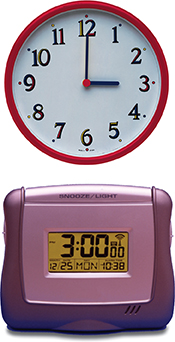Limits of Measurement
Suppose you wanted to measure how much time it takes for you to eat your breakfast. Figure 18 shows two clocks you could use—an analog clock and a digital clock. The analog clock displays time to the nearest minute. The digital clock displays time to the nearest second (or one sixtieth of a minute). Which clock would you choose?
Precision
The digital clock offers more precision. Precision is a gauge of how exact a measurement is. According to the analog clock, it might take you 5 minutes to eat your breakfast. Using the digital clock, however, you might measure 5 minutes and 15 seconds, or 5.25 minutes. The second measurement has more significant figures. Significant figures are all the digits that are known in a measurement, plus the last digit that is estimated. The time recorded as 5.25 minutes has three significant figures. The time recorded as 5 minutes has one significant figure. The fewer the significant figures, the less precise the measurement is.
When you make calculations with measurements, the uncertainty of the separate measurements must be correctly reflected in the final result.  The precision of a calculated answer is limited by the least precise measurement used in the calculation. So if the least precise measurement in your calculation has two significant figures, then your calculated answer can have at most two significant figures.
The precision of a calculated answer is limited by the least precise measurement used in the calculation. So if the least precise measurement in your calculation has two significant figures, then your calculated answer can have at most two significant figures.
Suppose you measure the mass of a piece of iron to be 34.73 grams on an electronic balance. You then measure the volume to be 4.42 cubic centimeters. What is the density of the iron?
Your answer should have only three significant figures because the least precise measurement, the volume, has three significant figures. Rounding your answer to three significant figures gives you a density of 7.86 grams per cubic centimeter.
Accuracy
Another important quality in a measurement is its accuracy. Accuracy is the closeness of a measurement to the actual value of what is being measured. For example, suppose the digital clock in Figure 18 is running 15 minutes slow. Although the clock would remain precise to the nearest second, the time displayed would not be accurate.
What is accuracy?
Figure 18 A more precise time can be read from the digital clock than can be read from the analog clock. The digital clock is precise to the nearest second, while the analog clock is precise to the nearest minute.






